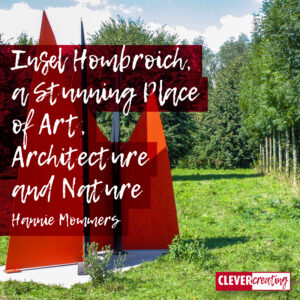
When I still lived in the Netherlands, Insel Hombroich was a car journey of 1,5 hours from our house. I have visited the location often with friends and family and it was a favourite day out for my staff and me.
An average museum visit lasts between one and two hours. Visiting Insel Hombroich can easily take up a whole day. One of the reasons why it is perfect for a short getaway.
The area is a breathtaking landscape full of little buildings, beautiful vegetation, and most of all a lot of art in all disciplines and genres.
Some of the links are affiliate links. As an affiliate associate, I earn a small commission when you purchase any of the products offered through the shared links at no extra cost to you. This helps me to maintain this website and I thank you for supporting me.
Table of Contents
Insel Hombroich, Germany
A marvellous combination of nature and culture can be found in Neuss, Germany, on the Insel Hombroich. All kinds of works of art are displayed in an unusual concept without a noticeable order.
An island in the river Erft
To be at Insel Hombroich is incredible. I have travelled and seen a lot, yet I don’t know of anything I can compare it with.
Part of it is a swamp on an island (Insel is German for island) that in the old times had no other function than to deliver willow branches. Part of it consists of an abandoned base where missiles were stationed.
Broker and art collector Karl-Heinrich Müller gave a sculptor friend, Erwin Heerich, the assignment to design several buildings. Heerich did an amazing job.
There are 15 buildings on the terrain. Almost all are earth-coloured brick on the outside and white on the inside. Some have a function as a museum, a concert hall, or a restaurant.
Others are completely empty, just standing on their own, being beautiful. I have visited this place at least 10 times and half the time there were people standing in these empty buildings humming or chanting. Truly amazing!
Compare it to children that can’t help themselves if they enter a tunnel, they just have to scream. Being in these empty buildings with their wonderful acoustics you cannot help but do something with your voice or clap your hands to hear the sounds and the echo.
Related: Museum LUMA in Arles, a Lively Creative Breeding Ground
It is a Museum. Actually, several little museums.
The owner of the swamp had a large art collection that is exhibited in several of the buildings. He believes you do not have to boast about the big names or the knowledge you possess once you see whose work it is. So there are no cards with names and information on the walls.
That’s an interesting approach. I like that. What I don’t like is that he pushes this idea of ‘art is beautiful in itself’ too far. There is no climate control in the buildings.
In some buildings, the doors are always open, so the humidity and the drought have free reign. Making the Rembrandt and Degas drawings look more crumbled each year. That hurts my artistic soul.
The collector had a very broad interest
There are 17th-century drawings, 20th-century paintings and statues, East-Asian art, Aboriginal art and much more. The little buildings in a way organize this variety because they all have their own focus.
One building only has 7 giant Buddha heads. Another building has just drawings on the wall.
The large buildings contain a collection of different periods and cultures that don’t seem to have a focus at all. It’s up to the viewers to make up their own minds about any connection they see, or not.

Outdoor art and nature
Walking around you fall from one surprise to another. One time you run into a tree that is at least 300 years old. The next time you encounter a 20th-century statue or a 3d object.
There are different types of landscapes in the area, including English gardens, wet biotopes, and terraces, which were designed by landscape architect Bernhard Korte.
The landscape is not just filled with objects placed outside, but there is also Land Art to admire. Land Art means that nature is formed into art. For instance, by putting trees in a pattern or by placing them diagonally together so that the branches later form the cover into a wigwam.
Related: Fantastic Outdoor Land Art on the Estate of Winery Chateau la Coste
Artists in residence
At times artists in residence lived here and left their mark, either outside or in the museum buildings.
Anatole Herzfeld, who made metal objects, lived here the longest until he passed away in 2019. We met Anatole Herzfeld a couple of times. Such a sweet man, who loved to talk about his artwork, although I was not quite in agreement with his ideas about the Russians. 🙂
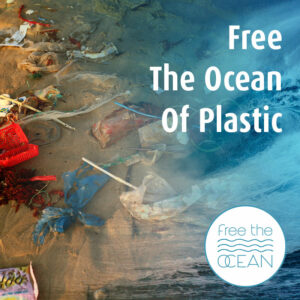
Lots of his work is on display in Insel Hombroich.
You can hike here for hours
Even if you are not very much into art the place is worthwhile visiting. The surroundings are beautiful. Lots of water (duh, it’s a swamp), vegetation that’s not imported but belongs there from ancient times, bridges, and hiking paths.
Exactly in the middle is the restaurant where you can pause at any time and take anything you want off the tables. The entrance fee is pretty high (15€, 2023), but it includes unlimited use of everything offered in the restaurant.
The food looks old-fashioned, with strange things that you don’t ordinarily eat at home. It’s great. (Well, as you have guessed by now, I am a true fan; I think everything is great in that place!). Coffee, tea, bread, a small lunch, whatever you want is on the tables.
The neighbours are interesting as well
You can visit the Langen Foundation, a 30-minute walk from Insel Hombroich. A modern museum, designed by Japanese Tadao Ando, with its exhibition space mainly underground. An intriguing building.
From the outside, you can hardly see it’s a museum because all the art is in the inner rooms. The only indication when we were there, was the big red LOVE in the pond.
The focus of the collection – a private collection of the couple Viktor and Marianne Langen – is on 20th-century art and traditional Japanese drawings.
In addition, the rocket launch site Raketenstation Hombroich and the sculpture gallery Thomas Schütte Foundation can be visited.
So even for a visit of a few days, there is plenty to do.
Route of industrial culture
Ever since the Ruhr area was the “European Capital of Culture” in 2010 the region has had a significant uplift. There is a 400 km route along all kinds of industrial monuments, including Zollverein Essen, which is great to do.
Related: Zollverein Essen and More Industrial Heritage in the Crammed Ruhr Area
Have you ever visited Insel Hombroich or the Ruhr area? Tell me what you think of it in the comment box.

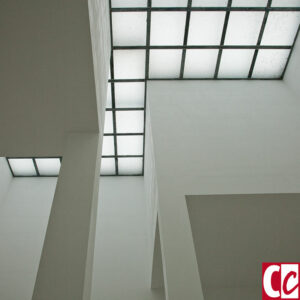
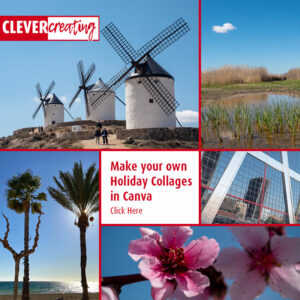



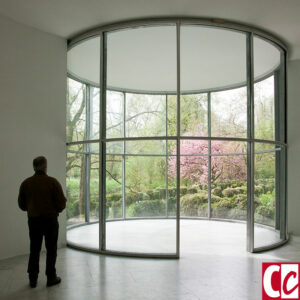

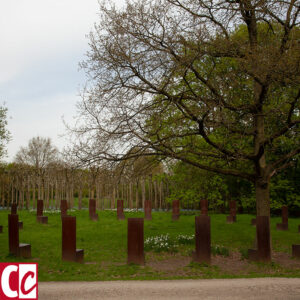

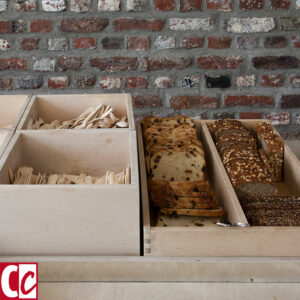
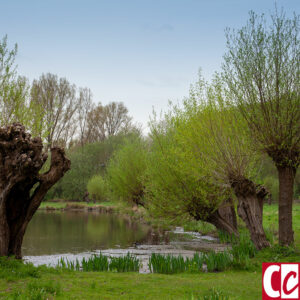
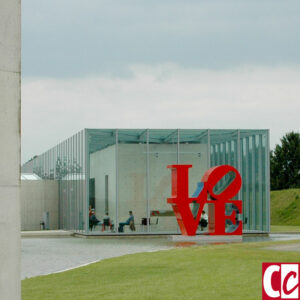
Never been to the Ruhr area nor Insel Hombroich, but it sounds charming!
I’m a hiking/art/museum kind of traveller myself, so this has definitely captured my attention!
I’m looking forward to when the borders will reopen and people feel safe enough to travel again and experience all these wonderful places.
My type of person, Andrea, I am the same as you. 🙂 There are so many places where we can combine all these activities and have a wonderful time.
Like you, and everybody else, I would desperately like to travel again! We will, in time!
Thanks for your comment and stay safe.
Hi Hannie,
I love art, especially permanent exhibits. What’s the deal with the Budda heads? The “witch” circle really intrigues me, and I wonder what the locals have to say about it.
I used to be an avid hiker and this island seems like it begs you to explore all you can. There must be some incredible hiking paths. It doesn’t seem too “swampy” from my point of view.
Thank you for this most fascinating look at one of your favourite areas, Hannie!
Frank
Hi Frank,
The owner of the island had an eclectic taste, so he collected all kinds of things. The Buddha heads are part of this collection. They look marvellous because of their size and also because of the little building they got all for themselves.
And the witch circle is a fitting name. 🙂 It looks beautiful in this natural environment, that’s why I had that association too!
It’s a private island and the nearest village is a couple of kilometres away, so we can’t really say there are any locals. The swampy parts are near the river. There are hiking paths next to it, but you are right – I haven’t shown any pictures of it! 🙂
Hi Hannie,
Your article made me want to visit the Ruhr area so badly…and yes, the combination of cultural activities, hiking, and nature activities is also my favourite. That’s why I think it’s a perfect destination for me.
A great article about Ruhr, and I will bookmark this in my browser for future travel plans.
Cheers,
Matt
I am so happy with everyone I can inspire to visit something, Matt, and especially this area, because a lot of people think it’s not worth visiting because of all the industry! There is beauty in everything as long as we are willing to see and experience it. 🙂
Hi Hannie!
Very interesting article, I didn’t know that you are writing about travels too! I have been to Germany more than 10 times, but I wasn’t aware about this place. Is this Hombroich island near Essen?
I was in Essen in 2013 playing an organ concert with a few colleagues – Price winners of international organ competitions at the Essen Philharmonic. I like the idea not to have the painters names on cards, it interrupts the concentration on a painting. Is it a modern art mostly? I’m personally not the fan of moderns arts, but nevertheless I would like to hang out there and see all these fancy things!
Alex
In the past I wrote a lot about my trips, Alex, and being unable to travel at the moment reignited my desire to share my experiences. 🙂
Isn’t that great that you played in the Philharmonic!! Wow. So now I have a famous organ acquaintance. I like that.
The art is a bit of everything, but honesty requires me to say that most is modern. I am biased. I LOVE modern art. For me it’s so much more interesting and varied than older art. Although I appreciate the Gothic churches and Renaissance sculptures too. And yes, the area is really interesting for non-modern art lovers as well. So it’ll be safe for you to visit it. 🙂
Hi Hannie,
I used to live in the Ruhr area, and I can confirm that it is indeed a very beautiful area, very green, with many lakes and hiking tours. I did not go to the places you visited, but I have been to other places and I loved it.
You made me curious about the Insel Hombroich. What city is near it? Is it Essen? I would love to visit that island one day when I go back to Germany and see the various art displays. It looks incredibly interesting, and the buildings look fascinating.
Where exactly did you live, Christine? You left Germany quite some time ago, didn’t you, so I don’t think Insel Hombroich existed then. The present form is founded in 1997. Essen is in the neighbourhood but said out of my head I would guess still some 50 km. Düsseldorf is closer and Neuss is the closest by if I remember correctly.
Yes, the white buildings are fascinating. I love that the place sort of developed both organically and planned. The entrance is way higher than the park, so as soon as you have passed the entrance building there is a lovely view over the whole area. It looks as if the buildings are scattered around randomly. 🙂
Thanks for your comment and have fun.
Hi Hannie,
Just reading your descriptions of the various activities, museums, art, architecture, etc. has reminded me what a beautiful part of the world this is.
So, once we are able to travel again, I think that Ruhr is definitely on the wish list.
I’m actually particularly taken with the idea of hiking (and obviously finding a restaurant in the middle, well you know me and food, LOL). This has become one of my favourite activities over the last few years – just walking, discovering, and being at peace with nature.
All-in-all, what a wonderful place.
Partha
Ahh, how I wish to be able to travel again as well, Partha. I hate these lockdowns. There are way too many over here.
Oh well, I love looking at my pictures. And when I write articles like these, every visit relives again, which is wonderful of course.
And you are so right, being able to walk in nature and let that peace enter our bodies is just plain wonderful. I am so grateful that is still possible.
Thanks for your comment and take care.
I have not yet visited the Ruhr area but it looks wonderful. I also love art and those museums sound wonderful although the one you described that is not climate controlled hurts my heart as I think of the works of Rembrandt and Degas being exposed to the elements to further disintegrate. I did not think that would be allowed in today’s society.
Thanks for this informative and well-written article.
Thanks so much for the compliment, Deb. 🙂
As for the climate control; it’s a private museum and a private collection. The owner can treat them as he wants. It hurts my artistic soul too, but it’s an old discussion in the art world.
Take for instance the Rietveld House in Utrecht, the Netherlands. This house was built for the Schröder family to last the rest of their lifetime. Which would be approximately 50 years at the time of building the house.
The house indeed deteriorated after 50 years, but many people wanted it to be put on the monument list and to restore it. So what counts most; the artistic aspiration or the historical value?
It’s a discussion that has not ended yet, as you can imagine!
As I was reading, I thought 15 euros for a visit to Insel Hombroich doesn’t sound too bad because there is much to see, and lunch is included. But if there are entrance fees to many of the sites of the Ruhr route, it could be an expensive trip.
Your pictures are beautiful. Do you take them yourself? If so, I need to hit you up for a course in photography. 🙂
Hi Andrew, nice! I made you enthusiastic 🙂
A lot of these places are free and the entrance fee of for instance the Bergbau Museum is €10. Sometimes they offer combination tickets. But yes, entrance fees in Germany and the Netherlands are pretty high.
Thank you so much for the compliment! Yes, these are my pictures. I have a lot of tutorials and information on this website, even some cheatsheets you can download for free! 🙂